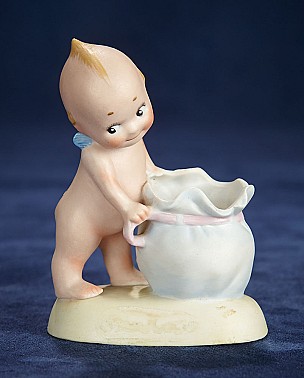French Bisque Art Character by Albert Marque in Original Ballet Russe Costume with Provenance
Lot #17
22" (56 cm.) Distinctively-sculpted bisque head achieved by four-part mold which lends definition to the temple and cheek bones, elongated slender throat, very full lower cheeks, rounded nose tip, closed mouth with solemn expression, distinctively modeled pierced ears, original brunette hand-tied human hair wig, uniquely-modeled body with elongated tapered-shape torso, wide hips, undefined waist, composition upper arms, bisque lower arms with attached bisque-ball-joints at the elbows, separately-sculpted fingers, wide upper thighs, elongated lower legs with shapely calves, elongated narrow feet. Condition: virtually mint condition, with flawless and exquisite bisque, enhanced by its early presence (#8) from the mold. Marks: A. Marque (incised signature) 8 (red ink number on head). Veronque (pencil lettered on foot). France, circa 1916, the model was sculpted by French artist, Albert Marque with a unique body design created by fellow artist. Aristodeme Botta; it is believed that only 100 examples of the doll were created. The Marque doll was a signature model of the French movement known as "Renaissance of the French Doll" whose purpose was to re-invigorate the 19th century French doll industry. To that end, celebrated French artist and sculptors, as well as couturier houses, were called upon to create new models and present them in exceptional costumes. One such group was presented in an exclusive exhibition at the fashion boutique of Parisian art patron, Margaine-Lacroix, about 1916. Showcased at that exhibition were several Marque dolls in costumes suggestive of the theatrical costumes designed for the popular Ballet Russe with particular attention to the Scheherazade opera whose dramatic Arabian Nights style costumes were designed by Leon Bakst. This doll is likely of that series, wearing its original costume of uniquely woven metallic gold costume edged with gold beads, matching slippers with leather soles impressed with figure of doll, matching turban with feathered trim, and blue and purple brocade silk jacket. Provenance: the doll was acquired directly from the Margaine-Lacroix Paris exhibition in 1916, and many years later was presented to that owner's son and daughter-in-law who founded the Museum of Old Dolls and Toys in Winter Haven, Florida. There the doll stood center-stage for decades, alongside its partner doll (#7 of the Marque series, sold by Theriault's in 2015). When the Museum closed its doors in 1984, both dolls were acquired by Lillian Hamm in whose home they resided until presented at auction by Theriault's.
























































































































































































































































































































































